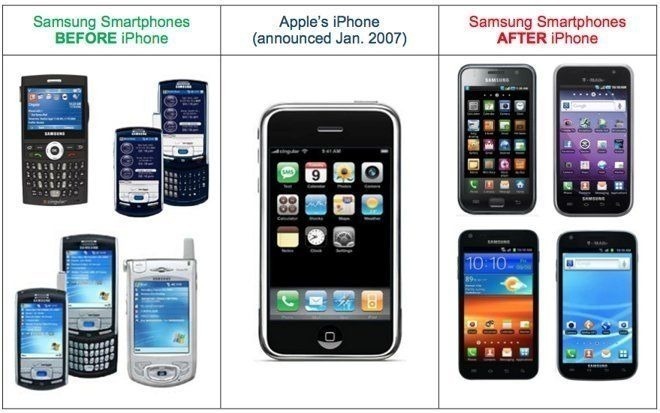Next month, Apple will continue its pursuit of hundreds of million of dollars in damages from Samsung as part of a protracted patent infringement case dating back to 2011. Unlike the original trial, however, the companies are keeping their respective top brass off the stand.
According to witness lists filed with the U.S. District Court for the Northern District of California last week, the highest ranking Apple executive set to appear in court is Greg Joswiak, VP of product marketing. Samsung America's SVP of mobile product strategy and marketing Justin Denison is the most notable witness for the Korean tech giant.
Joswiak is expected to discuss Apple's marketing strategy for iPhone, the role patents-in-suit played in said marketing strategy, drivers of demand for both Apple and competitors' devices, and other relevant topics during his time on the stand. Denison will talk about related issues, particularly Samsung device repairability, "holistic design," consumer response to Samsung products and the wider smartphone market.
Richard Howarth, senior director of the Apple Design Team, is also expected to make an appearance at the trial, where he will offer testimony on the company's design process. As a co-inventor of two patents-in-suit, Howarth, like other witnesses, will discuss "article of manufacture," a key issue in the retrial.
Former Apple designer Susan Kare, known for creating icons and fonts for the original Macintosh's graphical user interface, will appear in court to provide expert testimony on icon and GUI design. She will also discuss a patent related to iPhone's home screen, specifically identifying articles of manufacture to which Samsung applied the IP.
As noted by CNET, which reported on the witness lists on Monday, Samsung may call on testimony from Apple CDO Jony Ive and SVP of worldwide marketing Phil Schiller via deposition.
Samsung might also read from depositions provided by former Apple designer Christopher Stringer, former patent chief Boris Teksler and former designer Shin Nishibori.
Apple and Samsung are slated to meet in court on May 14 to kick off a damages retrial. The action stems from Apple's 2012 victory over Samsung, in which a federal jury in the same jurisdiction granted the iPhone maker more than $1 billion in damages after it found Samsung guilty of infringing on various design and utility patents.
Apple's win was significantly whittled down in a subsequent damages retrial. A successful Samsung appeal to the U.S. Court of Appeals for the Federal Circuit, alongside other lower court revisions, brought the figure down to $548 million.
Samsung elevated the case to the Supreme Court, arguing that damages in patent trials should be assigned based on a part or portion of profits attributable to an infringing part, not profits on a complete device.
Previous precedent referenced an "article of manufacture" as an entire device, meaning damages in a patent infringement suit would be calculated based on whole device sales. For products like iPhone, that figure is a gargantuan sum. Instead, Samsung argued damages should be limited only to those parts of a device found in infringement of a plaintiff's patents.
The Supreme Court agreed with Samsung's assessment, and in a unanimous decision in 2016 rewrote the book on how damages can be meted out in U.S. patent cases. However, the highest court in the land, as well as the CAFC, failed to specify guidelines in identifying an appropriate "article of manufacture," and thus handed the case back to trial court for determination.
In the coming trial, Samsung will continue to advocate for a restricted reading of articles of manufacture as it applies to iPhone, seeking to limit the scope of past damages rulings to a small number of individual components. Apple, meanwhile, will seek to prove Samsung's infringement of certain iPhone features is worthy of a more traditional view of article of manufacture.
 Mikey Campbell
Mikey Campbell







-m.jpg)






 Marko Zivkovic
Marko Zivkovic
 Christine McKee
Christine McKee
 Andrew Orr
Andrew Orr
 Andrew O'Hara
Andrew O'Hara
 William Gallagher
William Gallagher

 Mike Wuerthele
Mike Wuerthele
 Bon Adamson
Bon Adamson




-m.jpg)



6 Comments
The damages should have been twice the initial claim. It’s a travesty that they were reduced at all. Samsung’s entire modern telephony business is entirely dependent on what it stole from Apple.
What a pathetic farce.
I mean that oxymoron called the US justice system.
Oh my God. Why is this taking a decade to end!
It was reported in Korea that Samsung was behind the mocking of the families of the ferry accident that happened a few a ago. The families were fasting to protest the botched rescue effort when a ferry with hundreds of students sunk. Samsung paid a bunch of right wing goons to mock the fasting families by eating pizza and chicken next to the families of the victims and raising a ruckus. This company is the most vile and disgusting company in the world. All their products should be boycotted. We should urge apple not to use Samsung components in any of the apple products.